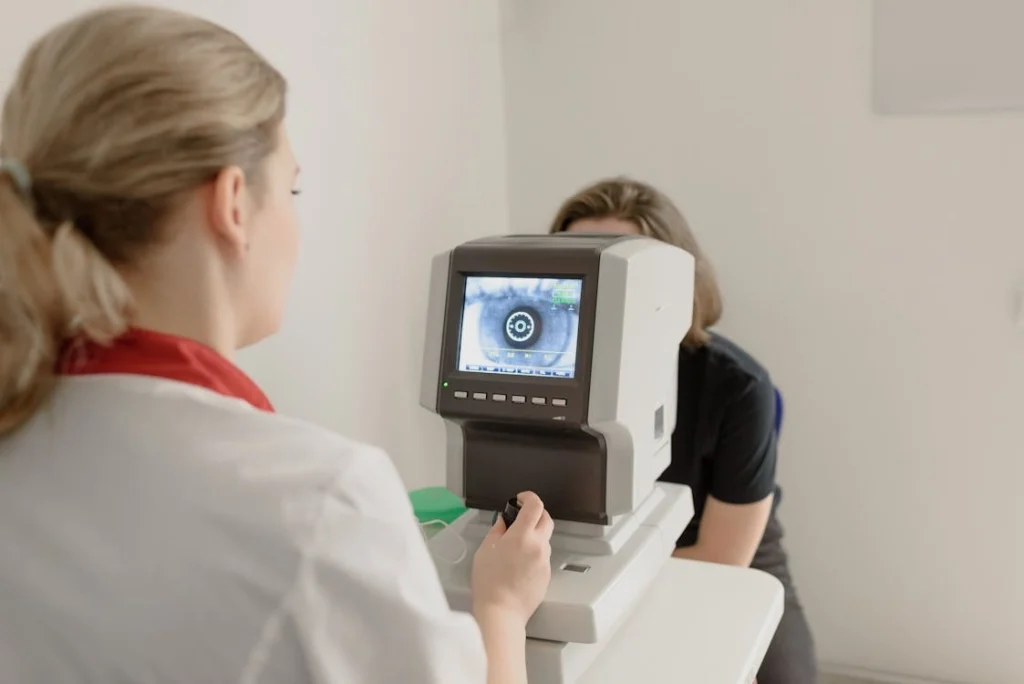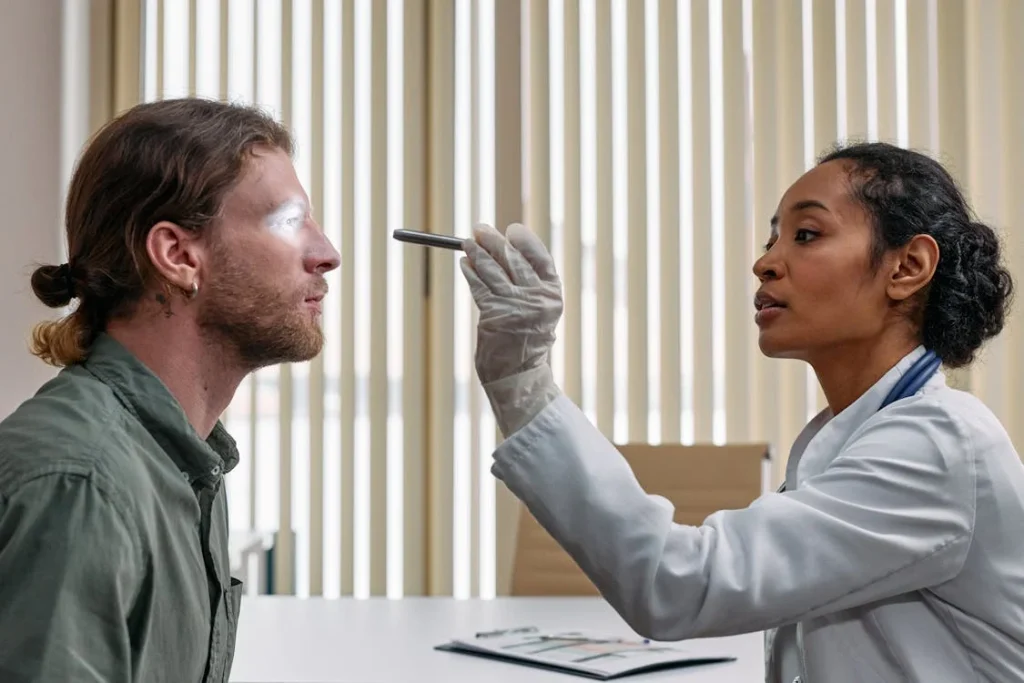
In recent years, the words “epidemic” and “pandemic” tend to appear in the news regarding new viruses or diseases. However, one of the fastest-growing diseases isn’t necessarily something new. It’s a condition you may already be familiar with: myopia. Myopia, or nearsightedness, is a refractive eye condition where you have difficulty seeing distant objects but can see objects close to you. This happens when the eye’s shape causes light rays to refract incorrectly, focusing images in front of the retina instead of on it.
To understand myopia better, it’s essential to delve into the anatomy of the eye. The eye works much like a camera, with light entering through the cornea, passing through the lens, and focusing on the retina at the back of the eye. A myopic eye consistently grows, either longer or curvier, causing light to focus in front of the retina. This misalignment results in distant objects appearing out of focus.
This condition is also becoming increasingly common, affecting individuals of all ages, particularly young people. According to the International Myopia Institute, the number of 17-year-olds with myopia doubled in the past decade. Based on this growth and previous estimations, experts believe that 5 billion people will have a myopia diagnosis by 2050.
This growth is a complicated matter, though. To analyze the reason behind this epidemic, we first have to explore the specifics of myopia itself and the prevention tactics known for the condition.
Why Does Myopia Occur?
Although experts haven’t been able to pinpoint a single cause of myopia, plenty of studies indicate a combination of factors. Let’s evaluate some of them.
Hormones and Health Conditions
No matter how slight, many conditions and bodily functions can significantly impact our eyes. For example, one 2015 study found that women with myopia experienced worsened symptoms of nearsightedness in the later stages of their menstrual cycle when their estrogen and progesterone hormones fluctuated more than in premenstrual stages. These two hormones can affect oil production in the eye, making the cornea less stiff, distorting the way light travels through the eye, and causing blurry vision. In addition, children going through puberty are more likely to experience myopia symptoms as their eyes grow due to the increased production of hormones that also spur growth to other parts of their bodies.
In addition, chronic conditions like diabetes can also impact your eyesight. When your body can’t process glucose effectively, your blood vessels and nerves may react and eventually become damaged, including the blood vessels in your eyes, which may be responsible for myopia.
Myopia may also have connections to health conditions beyond the physical. For example, a 2021 study of Chinese college students found that those who had high self-reports of anxiety also had myopia. The researchers did report limitations to this study that prevented them from definitively reporting that anxiety causes myopia. Since environmental factors, such as intense studying without breaks and screen time, can cause myopia and anxiety alike, researchers can’t definitively say the two share a causational relationship. Nevertheless, there is a relationship that future researchers must explore.
Genetic Conditions
More often than not, genetics plays a significant role in myopia. According to the National Library of Medicine, over 200 genes are responsible for myopia. These genes aren’t necessarily dominant or recessive, so predicting the likelihood of myopia isn’t always easy. However, children who have a parent or a sibling with myopia are more likely to receive a myopia diagnosis if they also share the same environment and lifestyle habits. This means even if you have myopia genes, you may not ever receive a diagnosis if you live in the right conditions.
Environmental Factors
The most prominent yet perplexing cause of myopia is environmental factors that cause the cornea, lens, or eyeball to change shape. Experts widely contest the actual reason behind this change — a debate that the Review of Optometry summarized in 2021. On the one hand, many experts believe that working with near-sighted work chronically in the day, whether reading or on a digital device, allows your eye to adapt to the conditions. Likewise, significant studies indicate that children who spend more time outdoors, therefore using farsightedness, are less likely to develop myopia. That said, some theorize the connection to the outdoors may be due to the release of dopamine, as myopia has been connected to hormones, as previously mentioned.

Why Is Myopia Becoming an Epidemic?
As nearsighted work becomes more prominent and a given to operate in today’s society, myopia continues to rise, particularly among East Asian countries. This is partially because countries like China, Taiwan, and Singapore also have a public school curriculum that requires students to study and read for long periods with little time to spend outdoors.
Many experts also estimate that the cultural shift to nearsighted work can be a potential cause of myopia. For example, because of the pandemic, more people work remotely now. Although this means less of a commute, which saves time, it also means less time using farsightedness. In addition, fewer people work in positions that allow people to take frequent breaks from nearsighted work, which can prevent the development of myopia.
Even though more experts can distinguish the causes and reasons behind this rise of myopia, many public officials hesitate to make any changes. According to Audrey Chia, a senior consultant at the Singapore National Eye Center (SNEC), myopia has become so common in the past two decades that “we’re almost numb to it.” However, without proper action on an individual, organizational, and government level, myopia could lead to a rise in more serious conditions such as cataracts, glaucoma, and macular degeneration.
What Are Governments and Organizations Doing to Address the Myopia Epidemic?
To prevent these severe conditions from rising, many Southeast Asian countries have created public health initiatives to address the extreme prevalence, as more than 80% of students have a myopia diagnosis, according to a review published by the Asia-Pacific Journal of Opthamalgy. In the same review, the Asia-Pacific Journal of Opthamalgy discusses different methods that Southeast Asian countries have used to prevent the myopia epidemic from growing among school children. In Singapore and Taiwan, students receive atropine eye drops that prevent myopia progression. China has also been establishing a goal to reform the public school standards, allowing students to feel less pressure to study and feel encouraged to spend more time outdoors.
Since myopia isn’t as prevalent in the United States, there have yet to be any public health initiatives preventing the spread of myopia. That said, many non-profits and organizations have risen to prevent this issue. For example, the Myopia Institute is a non-profit of ophthalmologists and other experts aiming to publish more research on myopia to advance treatment policies and educate policymakers, the general public, and educators about myopia to prevent it from worsening.
Can Myopia Lead to Blindness?
When children receive a myopia diagnosis, it’s typically a low or moderate case that can easily be corrected or controlled. However, left untreated, low or moderate myopia can progress to high myopia with age, which often leads to more serious issues, such as cataracts, glaucoma, retinal detachment, and macular degeneration. These conditions all share the notable symptom of partial, if not total, blindness. These conditions occur when the length of the eyeball stretches the optic nerve and retina, and the macula atrophies.
People who develop these conditions may not have such a serious prognosis early on. In fact, all of these conditions, particularly macular degeneration, progress with age. Therefore, the longer you go without going to an eye exam, seeking treatment, or utilizing preventative measures, the more likely you’ll develop high myopia or some of the conditions listed above.
Is Myopia Considered a Disability?
Myopia itself isn’t considered a disability because it can be corrected with eyeglasses, contact lenses, or LASIK surgery. However, it can progress to other vision conditions that are considered disabilities, such as cataracts, glaucoma, or macular degeneration. In all of these conditions, people may not be able to drive safely, they may not be able to work depending on their job, and they may not be able to enjoy old hobbies.
To receive government or compensation benefits for this, you must first receive documentation from an eye exam to evaluate how this condition affects your ability to work, drive, and overall quality of life. Still, people with impaired vision may encounter difficulties when discovering the lack of accommodations from other organizations and even their workplace. Some older adults, in particular, reported acts of discrimination from current and potential employers because of poor eyesight. To support these folks, many advocacy groups gather around these issues, aiming to promote equal opportunities among everyone, no matter their vision status.

Can You Reverse Myopia?
Unfortunately, there is no cure for myopia, and you can’t reverse it. However, eye doctors can halt its progression so it doesn’t develop into a severe condition that could lead to blindness with the following methods:
- Atropine eye drops: As a low dosage, kids who use atropine eye drops prevent the eye from elongating too much, although experts aren’t sure why.
- Peripheral defocus contact lenses: These contact lenses provide varying degrees of focus in the lens. The center corrects blurry vision while the side vision is blurry, which prevents myopia from worsening, particularly in genetic cases.
- Orthokeratology: This method involves overnight contact lenses that flatten your cornea at night. During the day, the shape of your cornea will adjust, allowing you to see long distances. However, they must be used chronically to prevent the growth of the eyes.
To treat myopia, no matter how far the progression is, providers will also recommend prescription eyeglasses or contact lenses that will correct the refractive issue of nearsightedness.
Can LASIK Fix Myopia?
In addition to eyeglasses and contact lenses, eye doctors may recommend LASIK surgery to correct myopia. Within this surgery, an eye doctor or surgeon will use a laser to change the shape of your cornea. In cases of myopia, the laser will correct any curvature or elongation of the cornea. This method is particularly effective for people who don’t want to deal with the hassle of wearing glasses or lenses or using eye drops every day. In addition, recent studies also applaud the effectiveness in preventing the progression of myopia. One 2017 study found that over 75% of myopic eyes grew only one diopter 12 years after the LASIK procedure.
LASIK does come with its risks, including the risk of infection, healing issues, or vision loss. However, most surgery participants aren’t likely to experience this. You also may not be eligible for LASIK if you are under 18 years old, if your vision has changed significantly in the past 12 months, or if you have a severe case of myopia. If you meet the criteria for surgery, you will reap the benefits for years to come despite the initial investment for LASIK.
Prevention and Mitigation
In addition to corrective lenses, prescriptive eye drops, and LASIK surgery, many researchers encourage lifestyle changes to prevent the development and progression of myopia, particularly among young people. As mentioned, researchers have debated why outdoor time prevents myopia development, from the hormonal benefits to the benefits of natural light. Still, they all agree that it does benefit people. Even just one hour outdoors can reduce your chance of developing high myopia by 2%. Experts also recommend:
- Working in well-lit areas to prevent eye strain;
- Taking frequent breaks from near-sighted work;
- Avoiding close screens from an early age;
- Getting plenty of sleep;
- Avoiding a diet of simple carbohydrates that increases your risk of insulin resistance.
Although some of these changes might not always be possible, especially as our society gravitates toward near-sighted work, we must explore these prevention methods to fully comprehend the connection and eventually find a true cure for myopia.
Until then, seeing an eye doctor is essential if you’re concerned you might have myopia. At Diagnostic Eye Center, we are dedicated to examining and treating most eye conditions with corrective surgery like LASIK to address and counteract myopia epidemic. By doing so, we hope to flatten the curve, one surgery at a time.
FAQs About Myopia
What Are the First Signs of Myopia?
The first signs of myopia typically include blurry vision when looking at distant objects, squinting to see, frequent headaches, and eye strain.
How Quickly Can Myopia Progress?
Myopia can progress rapidly, especially during childhood and teenage years. Annual eye exams are crucial to monitor vision changes.
Are There Age Restrictions for LASIK Surgery?
Yes, patients generally need to be at least 18 years old for LASIK surgery to ensure their eyes have stopped changing. Some doctors recommend waiting until your mid-20s.
What Lifestyle Changes Can Help Manage Myopia?
Lifestyle changes such as increasing time spent outdoors, managing screen time, using proper lighting when reading, and regular eye exams can help manage myopia.
Can Diet Affect Myopia?
While diet alone cannot prevent or treat myopia, a healthy diet supporting overall eye health can be beneficial. Nutrients like omega-3 fatty acids, lutein, and vitamins C and E are essential. In addition, avoiding simple carbohydrates, which can lead to insulin resistance, can help you avoid vision changes like myopia.
What Is the Difference Between Myopia and Astigmatism?
Myopia is nearsightedness, in which distant objects appear blurry. Astigmatism involves a distortion of vision — no matter the distance.
Can Myopia Be Cured?
There is no cure for myopia; however, its effects can be managed with corrective lenses, specialty eye drops, contact lenses, and surgical options like LASIK.
How Effective Are Contact Lenses in Treating Myopia?
Contact lenses are very effective in correcting myopia. They offer a particular field of vision that helps control eye growth and prevent myopia from progressing.
Is It Safe for Children to Undergo LASIK Surgery?
LASIK surgery is not recommended for children as their eyes are still developing. We recommend alternative treatments like corrective lenses or orthokeratology instead.
What Are the Long-Term Risks of Myopia?
Long-term risks of myopia include an increased chance of developing serious eye conditions like glaucoma, cataracts, macular degeneration, and retinal detachment.
